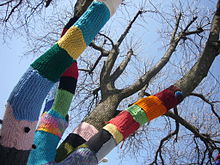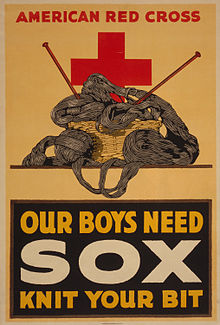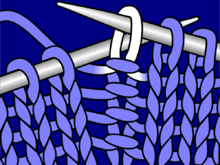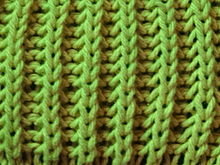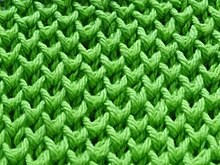Knit

Knitting is the production of textile mesh structures from yarns by looping around the thread, whereby the stitches are formed in a row one after the other. When knitting by hand, two to five knitting needles are used . In machine knitting, every wale needs a latch needle .
etymology
The word "stricken" goes back to the Old High German word strikkan , strikken and was derived from the noun knitting . In the German dictionary by Jacob and Wilhelm Grimm , the older, original meanings given are: "a loop, to tie a knot"; "tie". The younger use of the word, which was already in common use in the 19th century - the manufacture of textiles from a continuous thread with the help of two or more needles - was first documented by the Brothers Grimm in 1495.
history
Antiquity
Real knitted fabrics have not survived either from the ancient oriental or ancient civilizations; even indirectly, there is nothing to indicate that knitting could have been known at this time.
The oldest archaeologically secured textile fragments, which at least some researchers have classified as knitted fabrics , were found in Dura Europos in the 1920s and 1930s , one around 300 BC. Founded Roman fortress on the Euphrates in today's Syria . According to current estimates, these knitworks were not knitted with two needles, but needle-bound , i.e. made with a kind of sewing needle and made of relatively short threads. Even with socks worn in the 3rd – 5th Century AD made by Copts and later excavated in the Egyptian Oxyrhynchos (today: Al Bahnasa), it is not about knitted fabrics, but needle-bound work. Needle binding is much slower and more laborious than knitting, but it produces stronger meshworks that are also protected against running stitches .
middle Ages

A pair of bony needles, which was found in a woman's grave in Thuringia and dated to around 300 AD, is an indication of knitting knowledge in late antiquity . Comparable artifacts from around the same time were found in 1903 in a Roman burial ground in Metz . From the Merovingian period , namely from around the year 500, archeologically proven iron needles come from, which some researchers have also classified as knitting needles. However, it seems doubtful whether this classification is justified; because while woven fabrics were found that were 30,000 years old, the oldest preserved undoubted knitted fabrics date from the early Middle Ages. In museums, the highly sensitive old textiles are almost always kept in weak light and under glass, so that researchers hardly have the opportunity to precisely determine the method of manufacture. The Polish textile historian Irena Turnau, who has been looking at supposed knitted fabrics for years, suspects that only a few of them were actually knitted. In his standard work A History of Hand Knitting (1987) Richard Rutt reports on a knitted fabric fragment discovered in Fustāt , Egypt , which the Swiss textile expert Franz Iklé (1877–1946) dated 7–9. Century; older ones are not known.
Possibly it was the Arabs invading Spain who brought knitting to Europe. As an example of the highly developed knitting art of the Spanish Moors , which has been proven to be the case in the 8th century. a. who had introduced macrame technology , knitted pillowcases from the late 13th century, which were discovered in the tombs of the Castilian royal family , are believed. However, the number of finds is too small to scientifically secure the presumed origin of knitting in the Arab world.
The first pictorial representations of knitting appear in the High Middle Ages. The knitting Mother of God was depicted several times , for example in La Santa Famiglia ( Ambrogio Lorenzetti , around 1345), in Madonna dell'Umiltà ( Vitale da Bologna , 1353) and on the altarpiece of Our Lady (around 1400), attributed to Master Bertram , on Mary knits a skirt for the baby Jesus with four needles . The latter picture is also one of the oldest depictions of circular knitting with double pointed needles.
Knitting as a craft
The first mention of commercial knitting is in Paris in 1268 . The Parisian knitters' guild is also mentioned in 1366, 1380 and 1467. Also in Tournai (Doornik) in the then Burgundian Netherlands (1429) and in Barcelona (1496) guilds of knitters are notarized. The Nuremberg trouser and stocking knitters were first mentioned in a document for Germany in 1600 . The development of hand knitting into a recognized craft is evidenced not least by the rise of the Parisian hand knitters to one of the six most important craft guilds.
Outside of Europe
Knitted fabrics were almost unknown in Japan until the country welcomed the first foreigners in the mid-19th century. Hand knitting experienced the first spread with the disempowerment of the samurai and the reorganization of the military, which had a need for knitted gloves and tabi . In the literature it is occasionally reported that much of this knitting was done by samurai who were under economic pressure. However, the technology did not reach broader sections of the population until the 1870s with the increasing opening of the country and the establishment of Christian girls' schools, which were run by western missionaries. Towards the end of the 19th century, homework was used for knitting, which was replaced by knitwear factories in the early 20th century. At the same time, hand knitting spread in private households.
Knitting was also unknown in China for a long time. Traditionally, wool was felted or woven; Stockings were cut and sewn from woven fabrics. It was only with the import of knitted stockings and knitted underwear in the late 19th century that the technique became popular in China. The first knitwear factories opened in Hangzhou and Shanghai in 1902 and 1909 . At the same time, circular knitting machines were purchased in many private households for stocking production. Hand knitting was well known as early as the 1920s, but it was not until the early years of the People's Republic of China that it was most widespread .
Hand knitting
material
The material used is hand knitting yarn , which z. B. made of new wool , cotton , silk , cashmere , angora or synthetic fibers.
Tool
As a tool, you need knitting needles that can be made of coated steel , aluminum, brass, wood, plastic or carbon fibers . They are offered in different thicknesses (from 0.5–20 mm) to be able to be adapted to the yarn to be processed. There are different types:
The cardigan needles are pointed at one end and have a small knob at the other end so that the stitches cannot slip off the needle. They are usually around 35–40 cm long and the diameter is the same everywhere, or tapers in the direction of the knob on high-speed knitting needles. They are used in pairs for the production of flat knitted pieces such as jacket parts or scarves.
The double pointed needles usually consist of five individual needles of the same length and thickness, which are pointed at both ends. Their length ranges from 15 cm for gloves to 40 cm for sweaters and they are needed to produce tubular objects such as socks, collars or circular knitted sweaters.
The circular knitting needle consists of two shorter needles that are connected to one another by a nylon rope or a plastic-coated wire rope. It was developed for circular knitting, but can just as well be used for flat knitting, which has the advantage that you only need one needle, the work cannot slip off the needle, and the weight of the work rests in your lap and not on your arms.
technology
First a stop is made. To do this, as many stitches as are required for the width of the knitted piece are placed on a needle by knotting . A right-handed person takes this needle in the left hand and puts the thread hanging from the last stitch over the index finger around the other fingers. With the second needle held by your right hand you pierce the first stitch, grasp the tightly drawn thread with the needle, pull it through the stitch and let the old stitch slide off the left needle. The newly formed stitch is now on the right, the work needle. This is how you work stitch by stitch from the left needle to the right one.
If you want to produce flat workpieces, such as a scarf or the back of a jacket, you work in rows. To do this, all stitches are knitted from the left to the right needle, the work is turned by taking the full right needle in the left hand and the now empty left needle as a working needle. Now continue like this on the back of the piece. The resulting row is called the back row. Continue working row by row until you have reached the desired height of the workpiece. This method is called flat knitting or knitting back and forth or back and forth.
If you want to produce tubular workpieces, the row of stops is closed to form a circle. To do this, the stitches must be cast on on double pointed needles or a circular knitting needle. If you use double pointed needles, the stitches are usually distributed on four needles, and another is used to knit the stitches off. You now work continuously in a circle from the left to the right needle. When you get back to the starting point, you have completed a so-called round. Since you never have to turn the work with this variant, you always work on the front of the piece. This is particularly advantageous when knitting patterns because you always have the front in view. This method is called circular knitting .
When the required height of the workpiece has been reached, the stitches in the last row must be secured by binding off. There are different techniques for doing this.
A distinction is made between right and left stitches. Right stitches are also known as smooth stitches, and left stitches as reverse or curled stitches. The front of a right stitch looks the same as the back of a left stitch. Therefore, when flat knitting, right stitches are knitted on the outside (the right side) and purl stitches on the inside (the left side). The resulting pattern is also called "smooth right". In contrast, circular knitting often does not need to knit the purl stitches. To get a tube that is knitted in stocking stitch, only knit stitches have to be knitted.
By varying the right and left stitches, decreases and increases, yarn overs, interlacing the stitches and other types of stitch formation, you can knit different patterns (knitting patterns).
With the so-called double knitting method, which was mainly used in East Prussia , two different colored threads are knitted. This means that hats, stockings or gloves can be made in such a way that when the inside is completely turned outwards, the same pattern can be seen, but in the opposite color.
The knitting methods, so z. B. the position of the hands, the guidance of the working thread or the shape of the stitches differ regionally. With the knitting method common in German-speaking countries and Northern and Eastern Europe, the thread is stretched with the left hand and pulled through the existing loop with the right needle. With the knitting method common in the Anglo-Saxon-speaking area, southern Europe and along the Atlantic coast, the thread is passed with the right hand and wrapped around the work needle. In Peru, Portugal and Greece, the working thread is passed over the neck for tensioning.
Source material
Knitting wool , or “wool” for short, is a comparatively fluffy, soft thread with a twist, spun from sheep's wool, fibers from other animals or plants, synthetic fibers or mixtures thereof. In special cases, cut strips or even knitted ribbons or strings are knitted. Fancy may glittering Lurex contain filaments. A possibly pre-tensioned, mostly braided elastic thread made of elastane or a cord with small sequins can also be knitted .
Classically, wool is dyed wet after spinning. The thread is reeled onto a reel, the resulting winding with an internal diameter of about 30-40 cm is removed while the reel is folded and stretched into a strand that can be loosely clamped between two hooks. The skeins and balls offered in stores have a round weight - depending on the type, thread size and application - of 50–200 grams, for baby clothing only 25 g, particularly thick wool or even differently colored wool up to 500 g over the entire length. The barrel length per ball weight and weight requirement per standard sweater are typically mentioned. So that the parallel threads do not get tangled, the strand can be twisted, the winding can be tied with the thread itself at the reversal points and threaded through a narrow paper loop here. Alternatively, the whole strand is threaded through a paper band. The thread can hardly be entangled from the strand because of the risk of tangling. As a rule, the wool is unwound from the 15–40 cm long skein by helper or by means of a machine and rolled up into a ball.
Wound by hand, the result is compact, spherical balls, from which the outer thread end can only be pulled off. It is wound by machine in a moving diagonal direction over a core held on one side. Depending on the geometry, the result is an elongated ball (belted with a banderole) or a more flat and round one (the banderole is threaded through the central axis), both with a hollow space on the inside so that the thread can be knitted from the outside or from the inside layer as desired. Both are called "round balls" without being spherical. With a stronger rotation of the core, wool for knitting machines can be wound onto a cone that remains in it, from which it can only be unwound or pulled off from the outside, axially upwards. Alternatively, a flat cylindrical, also only slightly tapered roll is created, which - without a core, can also be used from the inside. Round as well as elongated balls can “run away” when the thread is pulled. A ball cannot run away if it is placed in a container.
Knitting results
Various types of clothing can be knitted such as stockings , sweaters , skirts , jackets , scarves , hoods and hats, but also lace blankets, curtains, carpets, etc.
Machine knitting
See also → knitting machine .
During the work the stitch row is created with all single stitch at a time when knitting the stitches are sequentially formed. In 1856 the Englishman Mathew Townsend from Leicester patented a jointed needle ( latch needle ). With the help of this needle, the knitting process became easier than with point needles. Durand invented the double latch needle in 1881. As a result, left-left knitting machines could now also be built. With regard to the design, a distinction is made between flat and circular knitting machines, which can be used for both manual and motorized operation.
Particularly fine knitted fabrics can be produced with industrial circular knitting machines; flat knitting machines use cotton, wool or synthetic yarns to produce items of clothing such as B. Sweater . How thick the fabric is wearing and what properties it has, it depends inter alia on the knitting machine , the type of yarn used, the used fiber material and the knitted construction from.
Industrial knitting and warp knitting machines are not to be equated with hand knitting machines or home knitting machines, as they were mainly used in the 1960s and 1970s in the domestic or hobby sector. The production of an item of clothing in one operation is not possible with such devices. The functionality is similar to that of an industrial machine, the stitches hang in a row on latch needles and are knitted using a movable carriage. The knitted fabric is then processed in the same way as for hand knitting.
Knitting techniques
Right and purl stitches
There are only two different types of stitches in knitting:
- the right or smooth stitch
- the left, wrong or frizzy stitch
Each of the two types of stitches forms the reverse side of the other, that is, right stitches appear when you turn the work over as purl stitches and vice versa.
More techniques
In addition to knitting right and purl stitches, u. a. the following techniques are used:
The following techniques are also worth mentioning:
- Crossing several stitches, for example for cables
- Casting on or adding stitches at the beginning of the knitted fabric or to increase the number of stitches
- Lift off stitches in order to create stitches that are elongated in height and extend over two or more rows, which are then often also crossed
- Cast off stitches at the end of the knitting
Knitting pattern
Two-dimensional patterns
Ajour knitting
Ajour, hole or lace knitting produces filigree, often highly complex, lace- like knits. Recurring increases and decreases here create rhythmic and ornamental sequences of structured surfaces, holes and bars.
Knitting
Knitting patterns can be noted with the help of knitting scripts , which are either represented as - mostly strongly abbreviated - text or graphically, using various symbols. An internationally consistent symbolism has not been able to prevail, although the Craft Yarn Council based in Carrollton , Texas, for example , is trying to standardize the symbols. As a rule, the knitting instructions or the corresponding work contain a breakdown of the symbols used. There is a special braille font for blind users .
See also
literature
History of knitting
- Ebba D. Drolshagen : Two right two left stories from knitting , Suhrkamp Verlag, Berlin 2017, ISBN 978-3-518-46814-2 .
- Sylvia Greiner: The cultural phenomenon of knitting. Hand knitting in a socio-historical context. Verlag Bernd A. Greiner, Weinstadt 2002, ISBN 3-935383-06-1 .
- Anne Macdonald: No Idle Hands: The Social History of American Knitting. Ballantine Books, 1990.
- Richard Rutt: A History of Hand Knitting. 1987.
- Susan M. Strawn, Melanie Falick: Knitting America: A Glorious Heritage from Warm Socks to High Art. Voyageur Press, 2007.
- Irena Turnau: History of knitting before mass production . Oficyna Wydawnicza "Akcent", Warszawa 1991, ISBN 83-900213-2-3 .
Web links
- History of knitting (English WP)
- Harro Albrecht: Digital knitwear. Retrieved November 2, 2016 (About Knitting in the IT Age).
Individual evidence
- ↑ Alois Kießling, Max Matthes: Textile specialist dictionary. Fachverlag Schiele & Schön, Berlin 1993, ISBN 3-7949-0546-6 , p. 363
- ↑ German Dictionary: stricken. Retrieved October 31, 2015 .
- ↑ Nancy Bush et al. a .: Knitting Socks From Around the World . Voyageur Press, 2011, ISBN 978-0-7603-3969-5 , pp. 373 ( limited preview in Google Book search).
- ↑ Ulrike Claßen-Büttner: Nalbinding - What in the World Is That ?: History and Technique of an Almost Forgotten Handicraft . Books on Demand, Norderstedt 2015, ISBN 978-3-7347-8775-1 , pp. 37 ( limited preview in Google Book search).
- ↑ a b On the history of hand-knitted stockings (www.deutsches-strumpfmuseum.de). (No longer available online.) Archived from the original on November 14, 2014 ; accessed on October 30, 2015 . Info: The archive link was inserted automatically and has not yet been checked. Please check the original and archive link according to the instructions and then remove this notice.
- ^ H. Graeven, H. Lehner: Museography about the year 1902 . In: H. Graeven, J. Hansen, H. Lehner (Eds.): West German magazine for history and art. Volume XXII . Jacob Lintz, Trier 1903, p. 358 ( limited preview in Google Book Search).
- ↑ Kerry Wills: The Close-Knit Circle . Praeger, Westport, CT, London 2007, ISBN 978-0-275-99246-0 , pp. 6 ( limited preview in Google Book search).
- ↑ Christina Cowden-Wüthrich: The sheep and its wool - historical excursus: From the beginnings of sheep breeding to today's standard of the wool seal - a teaching sequence in textile lessons at primary school . Schwäbisch Gmünd 2004, p. 82 ( limited preview in Google Book search). Scientific homework, Schwäbisch Gmünd University of Education; The healing power of stitches: history for knitting. (No longer available online.) Archived from the original on June 1, 2016 ; accessed on June 1, 2016 . Info: The archive link was inserted automatically and has not yet been checked. Please check the original and archive link according to the instructions and then remove this notice.
- ↑ The Story of Knitting in Japan, Part 1. Retrieved October 30, 2015 . , quoted from Yoshihiro Matushita: Amimono ima mukashi ( Knitting Today & Past ), in Nihon Vogue , 1986
- ^ The story of Knitting in Japan, Part 2. Retrieved October 30, 2015 .
- ↑ Antonia Finnane: Changing Clothes in China: Fashion, History, Nation . S. 120–123 ( limited preview in Google Book search).
- ^ Mizzi Donner, Carl Schnebel: Handicrafts like in grandmother's time . Ed .: Donner, Schnebel Berlin 1913. Weltbild Verlag, 1995, ISBN 3-89350-407-9 , pp. 75 ff .
- ↑ Therese de Dillmont: Encyclopedia of female handicrafts . Ed .: Th. De Dillmont, Dornach 1893. Reprint edition. Reprint Verlag, Leipzig, ISBN 3-8262-0401-8 , pp. 182 ff .
- ^ Three-Stitches Increase Into Same Stitch. Retrieved October 29, 2015 .
- ↑ Patent with deeper stitches - full patent - patent sample. Retrieved October 25, 2015 .
- ↑ Full patent knitting - patent pattern. Retrieved October 25, 2015 .
- ↑ Patent in rounds - patent pattern - knitting pattern. Retrieved October 25, 2015 .
- ↑ Half-patent knitting - patent pattern - knitting pattern. Retrieved October 26, 2015 .
- ↑ Knitting - Patent Pattern - Waffle Patent - Knitting Pattern. Retrieved October 26, 2015 .
- ↑ Ajour. Retrieved October 27, 2015 .
- ↑ Knit Chart Symbols. Retrieved October 28, 2015 .
